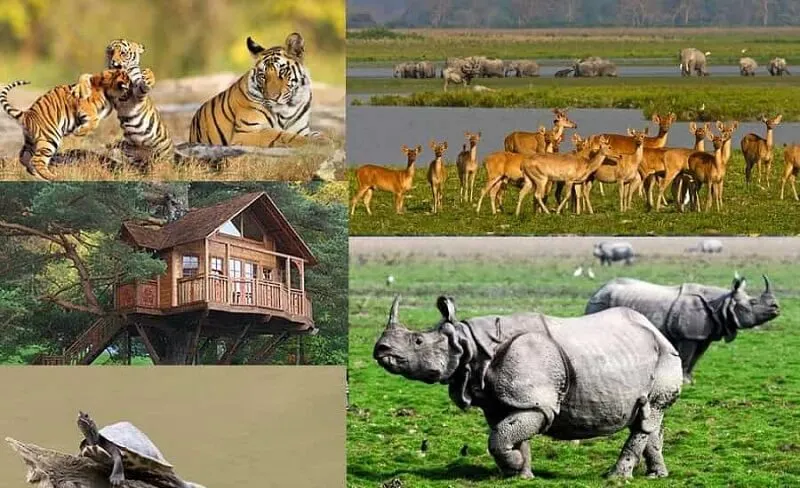Are you looking for a Kaziranga wildlife tour plan in Assam from Aborad? Then must go Kaziranga National Park, is known as the UNESCO World Heritage Site. This is one of India’s most iconic wildlife sanctuaries, renowned for its exceptional biodiversity, and commitment to conservation.

Kaziranga National Park is located in the North-Eastern state of Assam, and this park is a lush haven is home to some of the planet’s most magnificent creatures, including the endangered Indian one-horned rhinoceros and Bengal Tigers.
This blog will take you on a journey through the remarkable Assam landscapes and wildlife wonders of Kaziranga National Park. Apart from the best time to visit, the various Kaziranga Safari is available, to conservation efforts. Let’s explore why Kaziranga tour is most important for your next adventure to North East India tourism.
A Glimpse into Kaziranga National Park’s Rich Biodiversity
Kaziranga Park is spared to approximately 430 square K/M, and this Park is more than just a sanctuary for wildlife enthusiasts; it is a living example of ecological balance. Kaziranga is famous for its population of over 2,400 Indian one-horned rhinoceroses, which account for about two-thirds of the global population of the species.
However, Kaziranga Park is also a haven for a variety of other wildlife, such as Bengal tigers, Asian elephants, wild water buffalo, and an array of bird species. Book travel package from the USA, Italy, Uk to wildlife Kaziranga photography tour and enjoy unmated natural attractions with us. We are the best tour operator in Guwahati, Assam.
In addition to the ‘big four’—rhinos, tigers, elephants, and buffalo—the Kaziranga park is known for its more than 35 species of mammals and over 500 species of birds. Whether if you’re a birdwatcher, a wildlife photographer, or simply an adventurer traveller. Kaziranga offers a truly immersive experience into the wild. Book from Mumbai, Kolkata, and Bangalore to Kaziranga tour package, and enjoy orchid’s garden and jungle safaris.
About Flora and Fauna in Kaziranga National Park
Discover Kaziranga Park with varied ecosystems is characterized by tall elephant grass, dense tropical forests, and numerous water bodies. The mighty Brahmaputra River cuts across the northern part of the park, contributing to the fertile floodplains that support such rich biodiversity. Kaziranga floodplains are home to many rare and endemic species of flora, making the park a biological hotspot.
The park’s flood-prone grasslands play a crucial role in maintaining the health of the ecosystem. Seasonal flooding renews the nutrient-rich soil and creates a habitat for species such as hog deer, barasingha (swamp deer), and the Indian python. Apart from that, Kaziranga’s wetlands are also teeming with freshwater species, including fish and amphibians, making it a biodiversity-rich area. Assam Seasonal flooding renews the nutrient-rich soil and creates a habitat for species such as hog deer, barasingha (swamp deer), and the Indian python.
Explore Kaziranga’s Big Four: Rhino, Tiger, Elephant, and Buffalo
The highlight of any visit from Australia, France, USA, and Italy to Kaziranga National Park is encountering the majestic Indian one-horned rhinoceros. With its thick, armor-like skin and singular horn, the rhino is a traditional symbol of Assam strength and resilience. Book online Kaziranaga Jeep Safari or an Elephant Safari to offers incredible opportunities to spot these gentle giants and often seen grazing in the tall grasslands.
Kaziranga is also known a Tiger Reserve; it is a home to a healthy population of Bengal tigers. Although spotting a tiger in dense grasslands can be challenging. This Park’s tiger population is growing steadily, thanks to dedicated conservation efforts. The tigers here are an essential part of the park’s ecosystem, maintaining a delicate balance between prey and predator species.
Asian elephants, often spotted in Kaziranga, roam freely across the grasslands and forests. These elephants are integral to the Kaziranga National Park’s ecological dynamics, contributing to seed dispersal and forest regeneration.
The wild water buffalo, another star of the Kaziranga Park, is often seen wallowing in Kaziranga’s wetlands. With its curved, massive horns, the wild buffalo is a majestic animal and one of the rarest species in Assam.
Experience Jungle Safaris in Kaziranga National Park
Book a Kaziranga family tour plan from Mumbai, Guwahati, etc, and it is one of the best ways to explore the wildlife of Kaziranga National Park is through on a jeep safari or an elephant safari. Each mode of the transport offers a unique vantage point and experience.
Jeep Safari in Kaziranga National Park
Kaziranga jeep safari allows visitors to traverse the vast terrains of the park in relative comfort while maximizing the chances of spotting wildlife. The Kaziranga Park is divided into four different zones: Kohora (Central Range), Bagori (Western Range), Agaratoli (Eastern Range), and Burapahar (Ghorakati Range). Each of these Kaziranga’s major zones has its unique set of wildlife animals and landscapes.
The jeep safari is ideal for a wildlife photographer and family visitors, as it provides the flexibility to stop and observe animals from a distance without disturbing them. It’s also an opportunity to cover Kaziranga more ground and experience the diverse ecosystems—from grasslands to wetlands and dense forests. This type of safari is best for spotting animals like rhinos, Tigers, Buffalo, Elephants, and deer.
Elephant Safari in Kaziranga
If you want a more immersive and up-close experience, then book our Kaziranga elephant safari tour package from Western countries, and it is the perfect way to explore Kaziranga Park. Riding on the back of an elephant allows visitors to visit the park’s grasslands at a leisurely pace and gives you a better chance to observe the rhinos and other animals in their natural habitat. Elephant safaris usually occur early in the morning at 5.30 AM, as animals are most active during the cooler hours of the day.
Which is the best month to Couple tour plan for Kaziranga Park?
Every year of Kaziranga park is open from October to May, with the months from December to April month being the best for wildlife viewing. During this period, the Assam weather is pleasant, and animal sightings are frequent as the wildlife emerges from the thick grasses after the monsoon season.
Winter (November to February) is another popular time to holiday for Kaziranga Park. That time, Assam’s temperatures make it comfortable for visitors, and also the idol time to see migratory birds to flock to the park’s wetlands, offering an excellent opportunity for birdwatchers in Kaziranga National Park.
Conservation Efforts in Kaziranga National Park
Assam Kaziranga’s success story in wildlife conservation is an inspiring tale for the world. This park was established as a wildlife sanctuary in 1905, and since then, it has been at the forefront of conservation efforts. From protecting the endangered Indian rhinoceros to working on anti-poaching measures, the Kaziranga Park has implemented several strategies to protect its unique biodiversity.
One of the most significant challenges for the Kaziranga Park is dealing with poaching, particularly of rhinos for their horns. However, with the combined efforts of Assam forest rangers, local communities, and NGOs, poaching incidents have seen a decline in recent years. The introduction of technology such as drones, GPS tracking, and high-tech surveillance systems has played a crucial role in monitoring wildlife and preventing illegal activities.
How to Reach Kaziranga National Park?
Nearest Airport: Guwahati International Airport or Jorhat is your nearest Airport to reach Kaziranga National Park. From Guwahati to Kaziranga distance is approximately 210 K/M – 5hrs.
By Road: You can hire taxi, buses to reach Kaziranga Park from Guwahati city, or other major cities of Assam, and it is a perfect way for road trip travellers.
